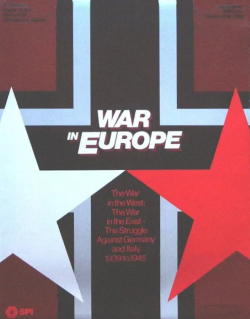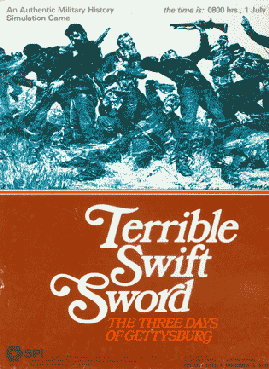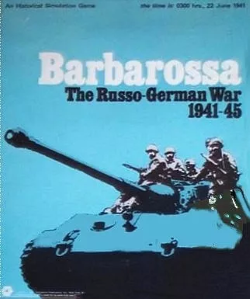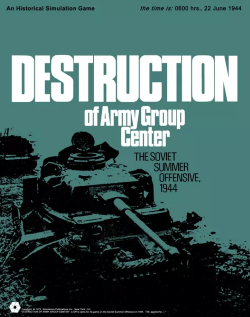
Winter War: The Russo-Finnish Conflict is a board wargame published by Simulations Publications Inc. (SPI) in 1972 that simulates the Soviet Union's 1939 invasion of Finland during World War II.

Winter War: The Russo-Finnish Conflict is a board wargame published by Simulations Publications Inc. (SPI) in 1972 that simulates the Soviet Union's 1939 invasion of Finland during World War II.
On 30 November 1939, three months after the Nazi-Soviet invasion of Poland that precipitated World War II, the Soviet Union invaded Finland. The subsequent conflict, known as the "Winter War" or the First Soviet-Finnish War, was not a walk-over by the Soviet Union despite superior military strength, especially in tanks and aircraft. The Soviet Union suffered severe losses and initially made little headway as Finland repelled Soviet attacks for more than two months and inflicted substantial losses on the invaders while temperatures reached as low as −43 °C (−45 °F). [1] The very poor performance of the Red Army convinced German Chancellor Adolf Hitler that an invasion of the Soviet Union would be successful, declaring, "we have only to kick in the door and the whole rotten structure will come crashing down". [2]
Winter War is a two-player board wargame where one player controls Soviet invasion forces, and the other the Finnish defenders. With only 120 counters and four pages of rules, this game has been characterized as being "at the simple end of the [complexity] spectrum." [3]
The Finnish player sets down their counters first, but upside down so that the Soviet player does not know the disposition of strengths. In addition, the Finnish player can mix in up to six dummy counters to camouflage strategic intentions. [3] The Soviet player then sets up their counters.
The game uses an alternating "I Go, You Go" series of turns, where the Soviet player moves and attacks, and then the Finnish player has the same opportunities.
A Soviet unit must attack an adjacent Finnish unit, but a Finnish unit does not have to attack an adjacent Soviet unit. In addition, before combat, the Finnish player has the opportunity to retreat away from the attacking Soviets. [4]
Each pair of player turns represents ten days, and the game ends after 10 turns.
In addition to moving units on foot with additional terrain penalties, each player has the opportunity to move units unlimited distances by train, although only on rail lines within their home countries. [5]
In the south of Finland (the southernmost 13 rows of hexes), both players can stack up to two units. In the north of Finland, no stacking of units is allowed. [5]
The most powerful units on both sides are prohibited from operating in the northern part of the map. [5]
Finnish units are never unsupplied within Finland. Soviet units must be able to trace an unhindered line back to a headquarters unit within five hexes, the headquarters units must be able to trace an unhindered line to a Russian city within ten hexes, and the Russian city must be able to trace an unhindered railway line to Leningrad. [4]
The game comes with two scenarios:
The Soviet player gains victory points for capturing key objectives: [5]
The Soviet player wins by earning at least 61 victory points. The Finnish player wins if the Soviet player earns 30 or fewer points. Anything in between is a draw.
Winter War was an early SPI product, designed by freelance game designer James Goff, with graphic design by Redmond A. Simonsen. The game was published as a free pull-out game in Issue 33 of SPI's house magazine Strategy & Tactics , and was also released as a boxed set.
In Issue 11 of the British magazine Games & Puzzles, Don Turnbull noted the "novel rules reflecting the harsh weather conditions, and a particularly intriguing supply rule which forces the Russian player, in particular, to plan very carefully." Turnbull concluded, "A fine game which I am sure will become very popular." [6]
In a 1976 poll conducted by SPI to determine the most popular board wargames in North America, Winter War placed 80th out of 202 games. [5] : 185
In his 1977 book The Comprehensive Guide to Board Wargaming , Nick Palmer used Winter War as an extensive introduction to the strategies of a board wargame, [5] : 44–48 calling it an "Exciting if rather luck-dependent game." [5] : 185 In his 1980 sequel, The Best of Board Wargaming , Palmer gave the game an Excitement grade of 80%, saying "Altogether a lively and varied game, though Lady Luck tends to dominate the scene." [3]
In Issue 12 of the British wargaming magazine Phoenix , Richard Stephens spoke about the spontaneity required to react to suddenly changing situations, saying "For me, this is the pleasure of the game — both sides really have to think as to what should be sent where, whether to give up such and such a position and so on, thus involving strategic decisions which makes it a very interesting simulation." [4]
In The Guide to Simulations/Games for Education and Training, Martin Campion called this game "an excellent simulation of a minor war." Commenting on its usefulness as an educational aid, Campion noted, "It is easy to learn and it shows the importance of supply, the effect of small numbers in a favorable situation and, conversely, the difficulty of making an impression with large numbers in an unfavorable situation." [7]

The Russian Campaign is a strategic board wargame published by Jedko Games in 1974 that simulates combat on the Eastern Front during World War II. Avalon Hill later bought the game and produced several editions.

1776, subtitled "The Game of the American Revolutionary War", is a board wargame published by Avalon Hill in 1974 that simulates the American Revolutionary War. Its release was timed to coincide with the bicentenary of the Revolution, and for several years was a bestseller for Avalon Hill.

Battle of the Bulge is a board wargame published by Avalon Hill (AH) in 1965 that simulates the World War II battle of the same name. General Anthony McAuliffe (ret.), who had been commanding officer at Bastogne during the Battle of the Bulge, was a consultant during the game's development. The game proved popular and sold more than 120,000 copies, but was dogged by criticisms of historical inaccuracies, and was finally replaced by a completely new edition in 1981. A third edition in 1991 was released as part of the Smithsonian American History Series.

War in Europe is a grand strategic "monster" board wargame published by Simulations Publications Inc. (SPI) in 1976 that attempts to simulate the entirety of the European theatre of World War II from 1939 to 1945. One of the largest wargames ever produced, War in Europe features 4000 counters, four rulebooks, and nine maps that when placed together cover an area of 38.5 ft2. The game is nominally a three-player game, but each side can be represented by teams of players. SPI estimated the full game would take at least 180 hours.

Terrible Swift Sword: Battle of Gettysburg Game is a grand tactical regimental level board wargame published by Simulations Publications, Inc. (SPI) in 1976 that simulates the Battle of Gettysburg during the American Civil War. A second edition was published by TSR in 1986.

NATO: Operational Combat in Europe in the 1970s is a board wargame published by Simulations Publications Inc. (SPI) in 1973 that simulates an invasion of Western Europe by the Warsaw Pact.

Barbarossa: The Russo-German War 1941–45 is a board wargame published by Simulations Publications Inc. (SPI) in 1969 that simulates the conflict between Germany and the Soviet Union on the Eastern Front of World War II. This was only SPI's second game produced during a preliminary round of "Test Series" games, and proved to be the most popular. Despite the title, taken from the German operational name for their initial invasion of the Soviet Union, the game covers the entire Eastern Front campaign from the German invasion in 1941 to the Fall of Berlin in 1945.

The Battle of Borodino: Napoleon in Russia 1812 is a board wargame published by Simulations Publications Inc. (SPI) in 1972 that is a simulation of the Battle of Borodino during the French invasion of Russia in 1812.

Destruction of Army Group Center, subtitled "The Soviet Summer Offensive, 1944" and often shortened to DAGC, is a board wargame published by Simulations Publications Inc. (SPI) in 1973 that simulates Operation Bagration, the June 1944 Soviet offensive during World War II that shattered the German line and marked the start of Germany's long retreat back to Berlin and the end of the war.

Kursk: Operation Zitadelle is a board wargame published by Simulations Publications Inc. (SPI) in 1971. It was the first wargame to simulate the Battle of Kursk, the large tank battle during World War II.

Korea: The Mobile War is a board wargame published by Simulations Publications Inc. (SPI) in 1969 that simulates the Korean War.

MechWar '77, subtitled "Tactical Armored Combat in the 1970s", is a board wargame published by Simulations Publications Inc. (SPI) in 1975 that simulates hypothetical tank combat in the mid-1970s between various adversaries, using the same rules system as the previously published Panzer '44.

The Moscow Campaign, subtitled "Strike and Counterstrike Russia", is a board wargame published by Simulations Publications Inc. (SPI) in 1972 that simulates combat near Moscow during World War II.

Napoleon at Waterloo is a board wargame published by Simulations Publications Inc. (SPI) in 1971 that simulates the Battle of Waterloo. The game, which features simple rules, was designed as an introduction to board wargaming, and was given as a free gift with each subscription to SPI's Strategy & Tactics magazine.

1918, subtitled "Operation Michel: March 21–30, Germany's Last Chance in the West", is a board wargame published by Simulations Publications Inc. (SPI) in 1970 that simulates Operation Michael, the final German offensive on the Western Front in which they tried to win the war or at least force peace talks before American soldiers started to arrive on the Western Front in force. The game was well received by critics, but did not sell well.

East Front is a board wargame published by The Control Box, Inc. in 1976 that simulates combat on the Russo-German Front during World War II. The game had unusual hexagonal-shaped counters rather than the more traditional square counters.

Mukden: Sino-Soviet Combat in the '70s is a board wargame published by Simulations Publications Inc. (SPI) in 1975 that simulates a contemporary hypothetical battle between Soviet and Chinese forces near the city of Mukden. It was one of four games that were part of the "quadrigame" titled Modern Battles: Four Contemporary Conflicts, but it was also released as an individual game. In a 1976 poll, Mukden was the least popular of the four games in Modern Battles.

Strike Force One, subtitled "The Cold War Heats Up — 1975", is a board wargame published by Simulations Publications Inc. (SPI) during the Cold War in 1975 that simulates a hypothetical clash in West Germany between Soviet Union invaders, and American defenders. The short and simple game was designed as an introduction to the hobby of wargaming, and was given away as a free promotional item.
World War II: European Theater of Operations is the title of two related but dissimilar board wargames that simulate the European Theater of World War II. The first was published by Simulations Publications Inc. (SPI) in 1973, and the second by TSR in 1985 following its takeover of SPI.

Turning Point: The Battle of Stalingrad is a board wargame published by Simulations Publications Inc. (SPI) in 1972 that simulates the Battle of Stalingrad during World War II, and the factors that led to the encirclement and destruction of Germany's Sixth Army.